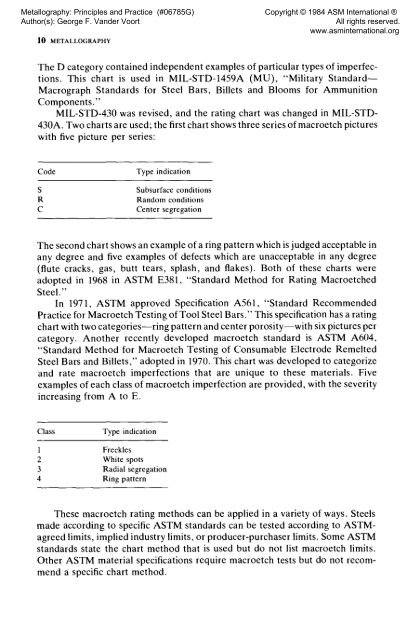Metallography: Principles and Practices - ASM International
Metallography: Principles and Practices - ASM International
Metallography: Principles and Practices - ASM International
You also want an ePaper? Increase the reach of your titles
YUMPU automatically turns print PDFs into web optimized ePapers that Google loves.
<strong>Metallography</strong>: <strong>Principles</strong> <strong>and</strong> Practice (#06785G)<br />
Author(s): George F. V<strong>and</strong>er Voort<br />
10 METALLOGRAPHY<br />
The D category contained independent examples of particular types of imperfections.<br />
This chart is used in MIL-STD-1459A (MU), "Military St<strong>and</strong>ard-<br />
Macrograph St<strong>and</strong>ards for Steel Bars, Billets <strong>and</strong> Blooms for Ammunition<br />
Components."<br />
MIL-STD-430 was revised, <strong>and</strong> the rating chart was changed in MIL-STD-<br />
430A. Two charts are used; the first chart shows three series of macroetch pictures<br />
with five picture per series:<br />
Code Type indication<br />
S Subsurface conditions<br />
R R<strong>and</strong>om conditions<br />
C Center segregation<br />
The second chart shows an example of a ring pattern which is judged acceptable in<br />
any degree <strong>and</strong> five examples of defects which are unacceptable in any degree<br />
(flute cracks, gas, butt tears, splash, <strong>and</strong> flakes). Both of these charts were<br />
adopted in 1968 in ASTM E381, "St<strong>and</strong>ard Method for Rating Macroetched<br />
Steel."<br />
In 1971, ASTM approved Specification A561, "St<strong>and</strong>ard Recommended<br />
Practice for Macroetch Testing of Tool Steel Bars." This specification has a rating<br />
chart with two categories—ring pattern <strong>and</strong> center porosity—with six pictures per<br />
category. Another recently developed macroetch st<strong>and</strong>ard is ASTM A604,<br />
"St<strong>and</strong>ard Method for Macroetch Testing of Consumable Electrode Remelted<br />
Steel Bars <strong>and</strong> Billets," adopted in 1970. This chart was developed to categorize<br />
<strong>and</strong> rate macroetch imperfections that are unique to these materials. Five<br />
examples of each class of macroetch imperfection are provided, with the severity<br />
increasing from A to E.<br />
Class Type indication<br />
1 Freckles<br />
2 White spots<br />
3 Radial segregation<br />
4 Ring pattern<br />
Copyright © 1984 <strong>ASM</strong> <strong>International</strong> ®<br />
All rights reserved.<br />
www.asminternational.org<br />
These macroetch rating methods can be applied in a variety of ways. Steels<br />
made according to specific ASTM st<strong>and</strong>ards can be tested according to ASTMagreed<br />
limits, implied industry limits, or producer-purchaser limits. Some ASTM<br />
st<strong>and</strong>ards state the chart method that is used but do not list macroetch limits.<br />
Other ASTM material specifications require macroetch tests but do not recommend<br />
a specific chart method.
















